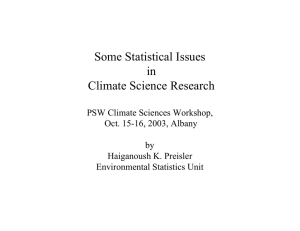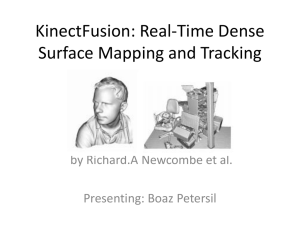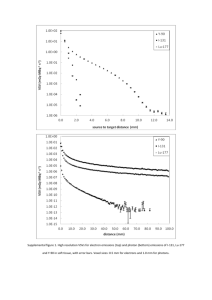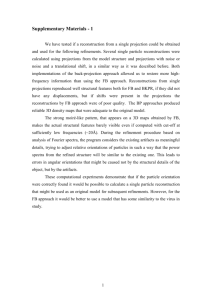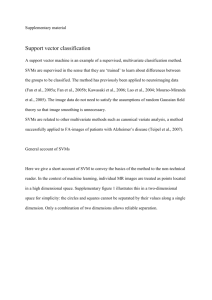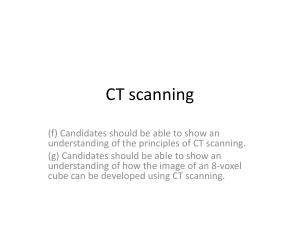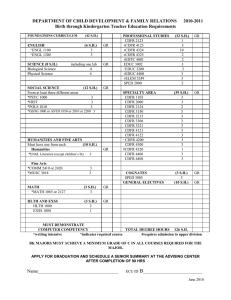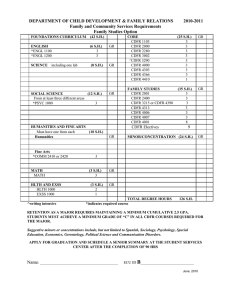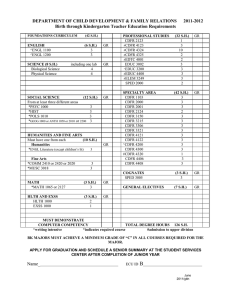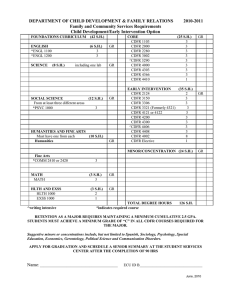Discrete Space, Voxelization and Distance Fields Jian Huang, CS 594, Spring 2002
advertisement
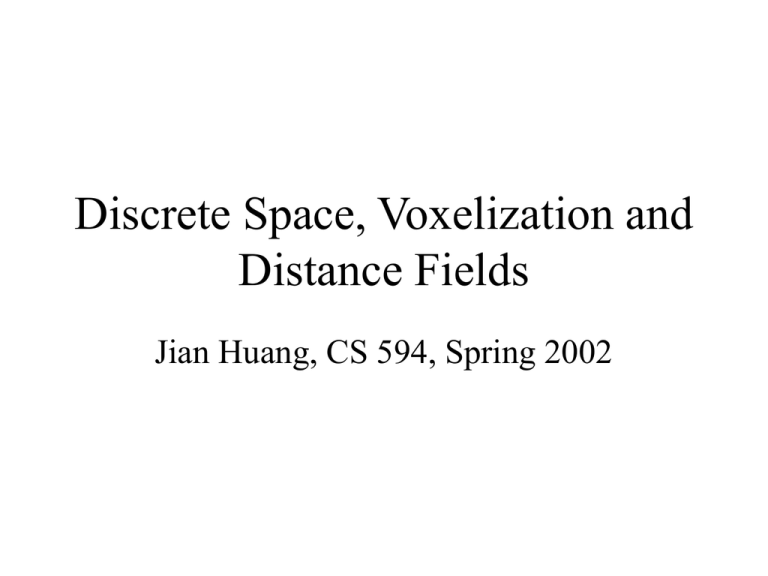
Discrete Space, Voxelization and
Distance Fields
Jian Huang, CS 594, Spring 2002
Papers
• Huang et al, ‘Accurate Voxelization of Polygonal
Meshes’, IEEE Symposium on Volume
Visualization, 1998
• Huang et al, ‘CDFR’, IEEE Conference on
Visualization, 2001
Discrete Space
• A 3D discrete space Z3 is a set of integer grid points in a 3D
• Euclidean space denoted by S. A 3D grid point is a zero
dimensional object defined by its Cartesian coordinate (x,y,z).
• The Voronoi neighborhood of grid point p is the set of all
points in the Euclidean space that are closer to p than to any
other grid point.
• The Voronoi neighborhood of a 3D grid point is a unit cube
around it, known also as a voxel.
Discrete Space
• The aggregate of all voxels is a tessellation of 3D
Euclidean space.
• A voxel’s value is mapped into the set {0,1}:
– voxels assigned the value “1'' are called “black'' or
“non-empty'' voxels
– those assigned the value “0'' are called “white'' or
“empty'' voxels
N-Adjacency
• In 3D discrete space
– Two voxels are 26-adjacent if they share a vertex or an
edge or a face
• 26 such adjacent voxels for any voxel
– Two voxels are 18-adjacent if they share an edge or a
face
• 18 such adjacent voxels for any voxel
– Two voxels are 6-adjacent if they share a face
• 6 such adjacent voxels for any voxel
• In 2D discrete space, similarly, 4-adjacency and 8adjacency.
N-Neighborhood
• The set of 2D pixels that are N-adjacent to the dark
pixel where N {4, 8}
• The set of 3D voxels that are N-adjacent to the
voxel at the center where N {6, 18, 26}
N-Path
• An N-path is a sequence of black voxels such that
consecutive pairs are N-adjacent
• Two black voxels are said to be N-connected in S if
there exists a connecting N-path consisting only of
black voxels
• A (closed) N-curve is an N-path P that either
contains a single voxel or each voxel in P has
exactly two N-adjacent voxels also in P
• An open N-curve is an N-curve with two exceptions
called endpoints, each of which has only one Nadjacent voxel in P
Separability
• In continuous space, it is impossible to pass from the region
enclosed by a curve to the region outside the curve without
crossing the curve itself.
• In discrete space, however, the opposite is possible.
• To avoid this discrepancy, define opposite types of
connectivity for white and black sets.
– Opposite types in 2D space are 4 and 8
– In 3D space, 6 is “opposite” to 26 and 18
Separability
• Let A, B and C be three disjoint sets of voxels. A is
said to N-separate B and C if any N-path P
between a voxel in B and a voxel in C meets A
• Separability is a topological property
4-separating and 8-separating curves
Minimality
• A voxel belonging to an N-separating surface is
called an N-simple voxel if deleting it will not
affect the surface separability.
• A surface is N-minimal if it does not contain any
N-simple voxels
Examples of a 4-minimal curve (left), 8-simple point
(center), and a 4-simple point (right).
Voxelization
• To convert continuous surface representations
(e.g. polygon mesh, parametric surfaces) into
voxel representations
• Need to preserve separability and minimality
Pixelizing a Line
• For 4-separable or 8-separable, assuming the normal vector
is normalized, need to include all pixels with distance to
the line between:
Voxelizing a Plane
• For 6-separable or 26-separable, assuming the normal
vector is normalized, all voxels with distance to the line
between: abs(Ax + By + Cz + D) <= t
Voxelizing a Polygon Mesh
• Edges and vertices needs special
handling for separability and
minimality
• Let t denote the desired
connectivity distance, either t6 or
t26.
• Rc = L/2 for 6-separability, for
26-separability:
Distance Field
• Discrete distance field
– Each element in a distance field specifies its
minimum distance to a surface geometry
– Positive and negative distances are used to
distinguish outside and inside of the shape
• negative values on the outside
• positive values on the inside.
Getting a Distance Field (1)
• First, voxelize the 3D mesh to a binary surface
volume [Kaufman, Cohen, Huang…]
• Second, run a distance transform on the surface
volume to obtain a solid distance volume
– Euclidean Distance
– Chamfer Distance
• Face, edge, vertex sharing
– Manhattan Distance
• Face sharing
Chamfer distance
Getting a Distance Field (2)
• Brute force: For every voxel in the volume,
compute the minimal distance to the
geometric surface
– Euclidean distance
• Doable with triangle meshes, but hard problem in
general
• Time consuming
Hierarchical Distance Field
• Distance fields can be stored hierarchically in
Quadtree or Octree structures
– Aka: adaptively sampled distance field (ADF)
• Use a smaller voxel size in areas of higher details
Disadvantages of Conventional
Distance Fields
• Need to choose an initial volume resolution
(the high limit of error tolerance)
– When the user picks a tighter tolerance, have to
do everything from scratch again
• The conventional distance volume is aliased
– Real data sets are not smooth, thus not bandlimited
Volume Anti-aliasing
• Non binary pre-filtered volume [Sramek & Kaufmann]
– Need higher order smoothing filters for
reconstruction
– No idea how much detail is gone in geometric
sense
• Not exactly sure about how geometric details are
defined
– Corners
– Holes
Impasse
• Sampling rate is limited
• Distance fields of complex geometric
models are not band-limited
• Impasse: would desire to keep all the
geometric details in a volumetric distance
field
– Geometric details at <0.1% of an object’s
dimension
Observation
• In spatial domain, if all that we want to capture are
the distances to a set of finite polygons
– Place an anchor point somewhere, and record the
distances from the anchor to each of the finite polygons
Need New Distance Field
Representation
• Generalize volume representation from a
discretization of a continuous domain entity to a
spatial data structure
• Try to build a spatial data structure
– Every voxel to have all the information necessary to
capture the exact local distance field within the span of
that voxel
– To answer a query of ‘what’s the thickness of an
interior point, pnt,’ we only have to deal with the
corresponding local voxel
CDFR
• The spatial data structure is named: CDFR
– A Complete Distance Field Representation
• In the CDFR, deal with signed Euclidean distances
from 3D points to finite triangles only
• Each spatial point has a base triangle, which is
used to determine the sign of the distance value
Base Triangle
• Need to decide which triangle is the base triangle
of a point, pnt
– If pnt is closest to a triangle which pnt orthogonally
projects into, then this triangle is the base triangle
– Otherwise, if pnt is closest to 2 triangles sharing an
edge, then compute pntproj on this edge, connect pnt and
pntproj to form a vector V
– Otherwise, pnt is closest to several triangles sharing a
common vertex, connect pnt and this vertex to form the
vector V
CDFR
• In a CDFR, the center of each voxel serves as an
anchor point that captures information for the
local distance field in its span
• First idea: each voxel stores the id of the base
triangle of its center and the corresponding signed
distance
• Not enough
– Don’t have the distance information for other locations
in the span of each voxel
How much information do we
need on each voxel?
• Theorem (please refer to paper)
– No triangle can be the base triangle to any
location in the span of a voxel, v, if its distance
to the center of v is larger than
thickness(v) + sqrt(3) x voxel_size
Constructing a CDFR
• First, pick an initial volume resolution
– Only affect the performance, not accuracy
• Second, voxelize the geometry into a surface
volume
– On each surface voxel, store those triangles that
intersect that voxel
– We store on each voxel a list of tuples:
{triangle_id, signed distance} //CDD tuples
• Third, an iterative contour-by-contour distance
transform to obtain the final solid CDFR
Distance Transform
• Loop:
– Each voxel not on the surface volume inherits the CDD
list from its 26-neighbors
– For all the new triangles that it sees, compute its
distance to each new triangle
– Update the curr_min_dist
– Discard all CDD tuples that have a distance larger than
curr_min_dist + sqrt(3)*voxelsize
• This loop ends until no new updates take place in the
CDFR
Answering a Query
• What is the minimal distance from an
arbitrary 3D point to the surface geometry
– Find out which voxel the point resides in, grab
all triangles on that voxel
– Compute the distance values from that point to
all those triangles
– The distance value with the minimal absolute
value is what we want
Extracting a Distance Contour
• A ‘Dividing Cube’ algorithm
• Extract a point-based distance contour of
thickness, t, with an error tolerance, E.
– Traverse the CDFR, grab all voxels with
min_distance in the range:
– Subdivide these voxels to size:
– Compute the thickness values of all the subvoxels and extract all sub-voxels whose
thickness are within [t - E/2, t + E/2]
On Convex Test Models
• 32x32x32 CDFR, 512 conventional res
3
On Concave Test Models
• 32x32x32 CDFR, 512 conventional res
3
On Practical Parts
• 128x128x128 CDFR, 1024 conventional
res
3
On Practical Parts
• 128x128x128 CDFR,1024 conventional
res
3
Storage Size
• Only store CDFR for surface and interior
voxels. For exterior voxels, just store a tag
denoting ‘empty’.
• CDD list for each voxel takes:
(5 + 4*triangle_cnt) bytes
CDFR Storage Size and
Construction Time
• Connector, 242 triangles, (6.9, 2.0, 2.9) inches
• Brevi, 1812 triangles, (38.1, 34.9, 96.0) inches
Voxel
Cnt (K)
Avg tri/surf
voxel
Avg tri/int
voxel
CDFR Size
(KB)
Time
(sec)
128 con
319
1.95
2.91
970
8
256 con
2,322
1.43
2.53
7,548
82
128 brevi
373
3.01
4.66
3,459
52
256 brevi
2,659
1.96
3.69
25,260
448
Testing Platform
• SGI Octane with 300MHz R12000
processor, 512 MB memory
Contour Extraction Time
• Depends on which thickness you pick
• For instance: brevi at 4 inches
Extraction
time (sec)
512 f-res
768 f-res
1024 f-res
128 CDFR
23.66
74.65
174.79
256 CDFR
9.25
28.29
64.46
• Higher CDFR resolution, trade storage for shorter
extraction time.
The Engine Cylinder Head
• Can build a 250-res 37MBytes CDFR in 30 min
• Can extract 0.137 mm accuracy at 8.5 mm thickness within
11 min (470K points, 1988x3500x1218)
2 frames/sec rendering of the pointbased model and sorted triangle mesh in
semi-transparent mode.
